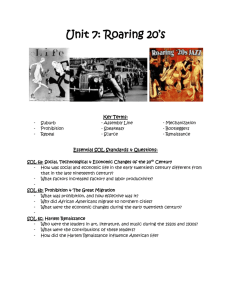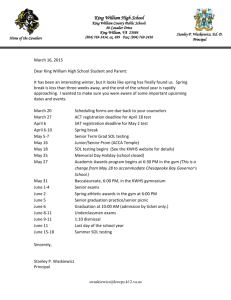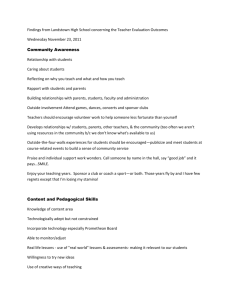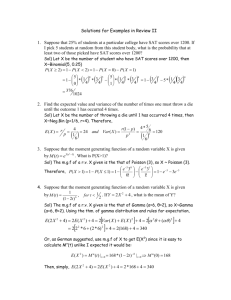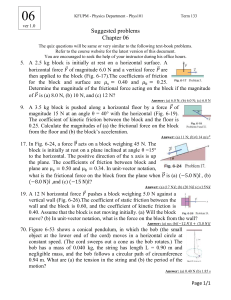Home Work Problems and Solutions1
advertisement
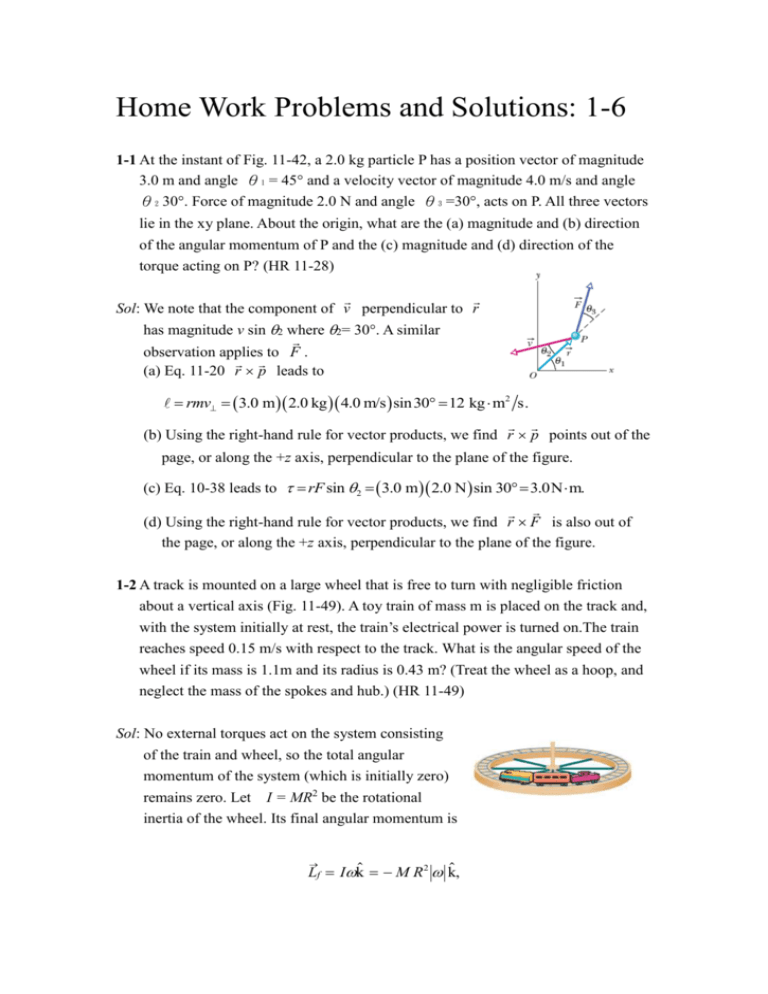
Home Work Problems and Solutions: 1-6
1-1 At the instant of Fig. 11-42, a 2.0 kg particle P has a position vector of magnitude
3.0 m and angle θ1 = 45° and a velocity vector of magnitude 4.0 m/s and angle
θ2 30°. Force of magnitude 2.0 N and angle θ3 =30°, acts on P. All three vectors
lie in the xy plane. About the origin, what are the (a) magnitude and (b) direction
of the angular momentum of P and the (c) magnitude and (d) direction of the
torque acting on P? (HR 11-28)
Sol: We note that the component of v perpendicular to r
has magnitude v sin where = 30°. A similar
observation applies to F .
(a) Eq. 11-20 r p leads to
rmv 3.0 m 2.0 kg 4.0 m/s sin 30 12 kg m2 s.
(b) Using the right-hand rule for vector products, we find r p points out of the
page, or along the +z axis, perpendicular to the plane of the figure.
(c) Eq. 10-38 leads to rF sin 2 3.0 m 2.0 N sin 30 3.0N m.
(d) Using the right-hand rule for vector products, we find r F is also out of
the page, or along the +z axis, perpendicular to the plane of the figure.
1-2 A track is mounted on a large wheel that is free to turn with negligible friction
about a vertical axis (Fig. 11-49). A toy train of mass m is placed on the track and,
with the system initially at rest, the train’s electrical power is turned on.The train
reaches speed 0.15 m/s with respect to the track. What is the angular speed of the
wheel if its mass is 1.1m and its radius is 0.43 m? (Treat the wheel as a hoop, and
neglect the mass of the spokes and hub.) (HR 11-49)
Sol: No external torques act on the system consisting
of the train and wheel, so the total angular
momentum of the system (which is initially zero)
remains zero. Let I = MR2 be the rotational
inertia of the wheel. Its final angular momentum is
Lf Ik M R2 k,
where k is up in Fig. 11-47 and that last step (with the minus sign) is done in
recognition that the wheel’s clockwise rotation implies a negative value for .
The linear speed of a point on the track is R and the speed of the train (going
counterclockwise in Fig. 11-47 with speed v relative to an outside observer) is
therefore v v R where v is its speed relative to the tracks. Consequently,
c
h
the angular momentum of the train is m v R R k . Conservation of angular
momentum yields
c
h
0 MR 2 k m v R Rk.
When this equation is solved for the angular speed, the result is
| |
mvR
v
(0.15 m/s)
0.17 rad/s.
2
M m R M / m 1 R (1.1+1)(0.43 m)
2-3 In Fig. 12-42, a 55 kg rock climber is in a lie-back climb along a fissure, with
hands pulling on one side of the fissure and feet pressed against the opposite side.
The fissure has width w0.20 m, and the center of mass of the climber is a
horizontal distance d =0.40 m from the fissure. The coefficient of static friction
between hands and rock is μ1 =0.40, and between boots and rock it is μ2 =1.2. (a)
What is the least horizontal pull by the hands and push by the feet that will keep
the climber stable? (b) For the horizontal pull of (a), what must be the vertical
distance h between hands and feet? If the climber encounters wet rock, so that μ1
and μ2 are reduced, what happens to (c) the answer to (a) and (d) the answer to
(b)? (HR 12-26)
Sol: (a) The problem asks for the person’s pull (his force exerted
on the rock) but since we are examining forces and torques on
the person, we solve for the reaction force FN 1 (exerted
leftward on the hands by the rock). At that point, there is also
an upward force of static friction on his hands f1 which we will
take to be at its maximum value 1 FN 1 . We note that equilibrium of horizontal
forces requires FN 1 FN 2 (the force exerted leftward on his feet); on this feet
there is also an upward static friction force of magnitude 2FN2. Equilibrium of
vertical forces gives
f1 + f 2 mg = 0 FN 1 =
mg
= 3.4 102 N.
1 + 2
(b) Computing torques about the point where his feet come in contact with the
rock, we find
mg d + w 1FN 1w
mg d + w f1w FN 1h = 0 h =
= 0.88 m.
FN 1
(c) Both intuitively and mathematically (since both coefficients are in the
denominator) we see from part (a) that FN 1 would increase in such a case.
(d) As for part (b), it helps to plug part (a) into part (b) and simplify:
a f
h = d + w 2 + d1
from which it becomes apparent that h should decrease if the coefficients
decrease.
2-4 In Fig. 12-50, a uniform plank, with a length L of 6.10 m and a weight of 445 N,
rests on the ground and against a frictionless roller at the top of a wall of height
h = 3.05 m. The plank remains in equilibrium for any value of θ≧ 70° but slips
if θ< 70°. Find the coefficient of static friction between the plank and the
ground. (HR 12-37)
Sol: The free-body diagram on the right shows
the forces acting on the plank. Since the
roller is frictionless the force it exerts is
normal to the plank and makes the angle
with the vertical. Its magnitude is
designated F. W is the force of gravity;
this force acts at the center of the plank, a distance L/2 from the point where the
plank touches the floor. FN is the normal force of the floor and f is the force of
friction. The distance from the foot of the plank to the wall is denoted by d. This
quantity is not given directly but it can be computed using d = h/tan.
The equations of equilibrium are:
horizontal force components
vertical force components
torques
F sin f 0
F cos W FN 0
FN d fh W d L2 cos 0.
The point of contact between the plank and the roller was used as the origin for
writing the torque equation.
When = 70º the plank just begins to slip and f = sFN, where s is the
coefficient of static friction. We want to use the equations of equilibrium to
compute FN and f for = 70º, then use s = f/FN to compute the coefficient of
friction.
The second equation gives F = (W – FN)/cos and this is substituted into the first
to obtain
f = (W – FN) sin /cos = (W – FN) tan .
This is substituted into the third equation and the result is solved for FN:
FN =
d L/2 cos + h tan
h(1 tan 2 ) ( L / 2)sin
W
W,
d + h tan
h(1 tan 2 )
where we have use d = h/tan and multiplied both numerator and denominator by
tan . We use the trigonometric identity 1+ tan2 = 1/cos2 and multiply both
numerator and denominator by cos2 to obtain
L
FN = W 1 cos 2 sin .
2h
Now we use this expression for FN in f = (W – FN) tan to find the friction:
f =
WL 2
sin cos .
2h
We substitute these expressions for f and FN into s = f/FN and obtain
L sin 2 cos
s =
.
2h L sin cos2
Evaluating this expression for = 70º, we obtain
6.1m sin2 70cos70
s =
= 0.34.
2 3.05m 6.1m sin70cos2 70
3-1 In Fig. 15-31, two identical springs of spring constant 7580 N/m are attached to
ablock of mass 0.245 kg. What is the frequency of oscillation on the frictionless
floor? (HR 15-13)
Sol: When displaced from equilibrium, the net force
exerted by the springs is –2kx acting in a direction
so as to return the block to its equilibrium position
(x = 0). Since the acceleration a d 2 x / dt 2 , Newton’s second law yields
d2x
m 2 = 2 kx.
dt
Substituting x = xm cos(t + ) and simplifying, we find
2 =
2k
m
where is in radians per unit time. Since there are 2 radians in a cycle, and
frequency f measures cycles per second, we obtain
f=
1
=
2 2
2k
1
m 2
2(7580 N/m)
39.6 Hz.
0.245 kg
3-2 In Fig. 15-36, two springs are joined and connected to a block of mass 0.245 kg
that is set oscillating over a frictionless floor. The springs each have spring
constant k = 6430 N/m. What is the frequency of the oscillations? (HR 15-26)
Sol:
We wish to find the effective spring constant for
the combination of springs shown in the figure.
We do this by finding the magnitude F of the force
exerted on the mass when the total elongation of the springs is x. Then keff =
F/x. Suppose the left-hand spring is elongated by x and the right-hand spring
is elongated by xr. The left-hand spring exerts a force of magnitude kx on
the right-hand spring and the right-hand spring exerts a force of magnitude kxr
on the left-hand spring. By Newton’s third law these must be equal, so x xr .
The two elongations must be the same and the total elongation is twice the
elongation of either spring: x 2 x . The left-hand spring exerts a force on the
block and its magnitude is F kx . Thus keff kx / 2xr k / 2 . The block
behaves as if it were subject to the force of a single spring, with spring constant
k/2. To find the frequency of its motion replace keff in f 1 / 2 keff / m with
a f
k/2 to obtain
1
k
.
2 2m
With m = 0.245 kg and k = 6430 N/m, the frequency is f = 18.2 Hz.
f=
suppose the amplitude xm is given by
3-3 For Eq. 15-45,
where Fm is the (constant) amplitude of the external
oscillating force exerted on the spring by a rigid support in Fig.
15-15. At resonance, what are the (a) amplitude and (b)
velocity amplitude of the oscillating object? (HR 15-61)
Sol:
(a) We set = d and find that the given expression reduces to
xm = Fm/b at resonance.
(b) since the velocity amplitude vm = xm, at resonance, we
have vm = Fm/b = Fm/b.
3-4 In Fig. 15-60, a solid cylinder attached to a horizontal spring (k = 3.00 N/m) rolls
without slipping along a horizontal surface. If the system is released from rest
when the spring is stretched by 0.250 m, find (a) the translational kinetic energy
and (b) the rotational kinetic energy of the cylinder as it passes through the
equilibrium position. (c) Show that under these conditions the cylinder’s center
of mass executes simple harmonic motion with period T = 2π(3M/2k)1/2
where M is the cylinder mass. (Hint: Find the time derivative of the total
mechanical energy.) (HR 15-106)
Sol:
(a) The potential energy at the turning point is
equal (in the absence of friction) to the total
kinetic energy (translational plus rotational) as it
passes through the equilibrium position:
1 2 1
1 2 2 1
11
v
2
2
kxm Mvcm
I cm
Mvcm
MR 2 cm
2
2
2
2
22
R
1
1
3
2
2
2
Mvcm
Mvcm
Mvcm
2
4
4
2
2
which leads to Mvcm
2kxm2 / 3 = 0.125 J. The translational kinetic energy is
2
therefore 12 Mvcm
kxm2 / 3 0.0625 J .
(b) And the rotational kinetic energy is
1
4
2
Mvcm
kxm2 / 6 0.03125J 3.13 102 J .
(c) In this part, we use vcm to denote the speed at any instant (and not just the
maximum speed as we had done in the previous parts). Since the energy is
constant, then
dE d 3
d 1 2 3
2
Mvcm
kx Mvcm acm kxvcm 0
dt dt 4
dt 2
2
which leads to
acm =
2k I
F
G
H3 M J
Kx.
Comparing with Eq. 15-8, we see that 2 k / 3M for this system. Since
= 2/T, we obtain the desired result: T 2 3M / 2k .
4-1 A uniform rope of mass m and length L hangs from a ceiling. (a) Show that the
speed of a transverse wave on the rope is a function of y, the distance from the
lower end, and is given by v = (gy)1/2. (b) Show that the time a transverse wave
takes to travel the length of the rope is given by t = 2(L /g)1/2. (HR 16-25)
Sol: (a) The wave speed at any point on the rope is given by v =
,
where is the tension at that point and is the linear mass density.
Because the rope is hanging the tension varies from point to point.
Consider a point on the rope a distance y from the bottom end. The
forces acting on it are the weight of the rope below it, pulling
down, and the tension, pulling up. Since the rope is in equilibrium,
these forces balance. The weight of the rope below is given by gy, so the tension
is = gy. The wave speed is
v gy / gy.
(b) The time dt for the wave to move past a length dy, a distance y from the
bottom end, is dt dy v dy
gy and the total time for the wave to move the
entire length of the rope is
L
t
L
0
dy
y
2
g
gy
2
0
L
.
g
4-2 The type of rubber band used inside some baseballs and golf balls obeys Hooke’s
law over a wide range of elongation of the band. A segment of this material has
an unstretched length L and a mass m. When a force F is applied, the band
stretches an additional length ΔL . (a) What is the speed (in terms of m, ΔL ,
and the spring constant k) of transverse waves on this stretched rubber band? (b)
Using your answer to (a), show that the time required for a transverse pulse to
travel the length of the rubber band is proportional to 1/(ΔL) 1/2 ifΔL << L and is
constant ifΔL>>L. (HR 16-89)
Sol: (a) The wave speed is
v
F
k
k ( )
.
m /( )
m
(b) The time required is
t
Thus if
t
/
m
1 .
v
k
k ( ) / m
1, then t
/ 1/ ; and if
/
1, then
m / k const.
4-3 Underwater illusion. One clue used by your brain to determine the direction of a
source of sound is the time delay Δt between the arrival of the sound at the ear
closer to the source and the arrival at the farther ear. Assume that the source is
distant so that a wavefront from it is approximately planar when it reaches you,
and let D represent the separation between your ears. (a) If the source is located at
angleθin front of you (Fig. 17-31), what is Δt in terms of D and the speed of
sound v in air? (b) If you are submerged in water and the sound source is directly
to your right, what is Δt in terms of D and the speed of sound vw in water? (c)
Based on the time-delay clue, your brain interprets the submerged sound to arrive
at an angleθfrom the forward direction. Evaluateθfor fresh water at 20°C. (HR
17-12)
Sol: The key idea here is that the time delay t is due to the
distance d that each wavefront must travel to reach your left
ear (L) after it reaches your right ear (R).
d D sin
.
v
v
(b) Since the speed of sound in water is now vw , with 90 , we have
(a) From the figure, we find t
tw
D sin 90 D
.
vw
vw
(c) The apparent angle can be found by substituting D / vw for t :
t
D sin D
.
v
vw
Solving for with vw 1482 m/s (see Table 17-1), we obtain
v
1 343 m/s
1
sin
sin (0.231) 13
1482 m/s
vw
sin 1
4-4 In Fig. 17-42, a French submarine and a U.S. submarine move toward each other
during maneuvers in motionless water in the North Atlantic. The French sub
moves at speed vF = 50.00 km/h, and the U.S. sub at vUS = 70.00 km/h. The
French sub sends out a sonar signal (sound wave in water) at 1.000 × 103 Hz.
Sonar waves travel at 5470 km/h. (a) What is the signal’s frequency as detected
by the U.S. sub? (b) What frequency is detected by the French sub in the signal
reflected back to it by the U.S. sub? (HR 17-61)
Sol: We denote the speed of
the French submarine by
u1 and that of the U.S. sub
by u2.
(a) The frequency as detected by the U.S. sub is
v u2
5470 km/h 70.00 km/h
3
3
f1 f1
(1.000 10 Hz)
1.022 10 Hz.
v
u
5470
km/h
50.00
km/h
1
(b) If the French sub were stationary, the frequency of the reflected wave would
be fr = f1(v+u2)/(v – u2). { fdetected = fsource(v+u2)/v, freflected = fdetectedv/(v – u2) }
Since the French sub is moving towards the reflected signal with speed u1, then
(v u1 )(v u2 ) (1.000 103 Hz)(5470 50.00)(5470 70.00)
v u1
f r f r
f
1
v (v u 2 )
(5470)(5470 70.00)
v
1.045 103 Hz.
5-1 The orbit of Earth around the Sun is almost circular: The closest and farthest
distances are 1.47× 108 km and 1.52 × 108 km respectively. Determine the
corresponding variations in (a) total energy, (b) gravitational potential energy, (c)
kinetic energy, and (d) orbital speed. (Hint: Use conservation of energy and
conservation of angular momentum.) (HR 13-87)
Sol: (a) The total energy is conserved, so there is no difference between its values at
aphelion and perihelion.
(b) Since the change is small, we use differentials:
6.67 1011 1.99 1030 5.98 1024
GM E M S
5 109
dU
dr
2
2
11
r
1.5 10
which yields U 1.8 1032 J. A more direct subtraction of the values of
the potential energies leads to the same result.
(c) From the previous two parts, we see that the variation in the kinetic energy K
must also equal 1.8 1032 J.
(d) With K dK = mv dv, where v 2R/T, we have
2π 1.5 1011
v
1.8 10 5.98 10
3.156 107
32
24
which yields a difference of v 0.99 km/s in Earth’s speed (relative to the Sun)
between aphelion and perihelion.
5-2 The fastest possible rate of rotation of a planet is that for which the gravitational
force on material at the equator just barely provides the centripetal force needed
for the rotation.(Why?) (a) Show that the corresponding shortest period of
rotation is T = (3π/Gρ)1/2 where is the uniform density (mass per unit volume)
of the spherical planet. (b) Calculate the rotation period assuming a density of 3.0
g/cm3, typical of many planets, satellites, and asteroids. No astronomical object
has ever been found to be spinning with a period shorter than that determined by
this analysis. (HR 13-90)
Sol: If the angular velocity were any greater, loose objects on the surface would not
go around with the planet but would travel out into space.
(a) The magnitude of the gravitational force exerted by the planet on an object of
mass m at its surface is given by F = GmM / R2, where M is the mass of the planet and R
is its radius. According to Newton’s
second law this must equal mv2 / R, where v is the
speed of the object. Thus,
GM v 2
= .
R2
R
3
Replacing M with (4/3) R (where is the density of the planet) and v with
2R/T (where T is the period of revolution), we find
4
4 2 R
G R =
.
3
T2
We solve for T and obtain
T
3
.
G
(b) The density is 3.0 103 kg/m3. We evaluate the equation for T:
T
3
6.86 103 s 1.9 h.
3
3
6.67 10 m / s kg 3.0 10 kg/m
11
3
2
5-3 Several planets (Jupiter, Saturn, Uranus) are encircled by rings, perhaps composed
of material that failed to form a satellite. In addition, many galaxies contain
ring-like structures. Consider a homogeneous thin ring of mass M and outer radius
R (Fig. 13-55). (a) What gravitational attraction does it exert on a particle of mass
m located on the ring’s central axis a distance x from the ring center? (b) Suppose
the particle falls from rest as a result of the attraction of the ring of matter. What is
the speed with which it passes through the center of the ring? (HR 13-99)
Sol: (a) All points on the ring are the same distance (r =
x2 + R2 ) from the particle, so the gravitational
potential energy is simply U = –GMm/ x2 + R2 .
The corresponding force (by symmetry) is expected to
be along the x axis, so we take a (negative) derivative
of U (with respect to x) to obtain it. The result for the
magnitude of the force is GMmx(x2 + R2)3/2.
(b) Using our expression for U, then the magnitude of the loss in potential energy
as the particle falls to the center is GMm(1/R 1/ x2 + R2 ). This must “turn
1
into” kinetic energy ( 2 mv2 ), so we solve for the speed and obtain
v = [2GM(R1 – (R2 + x2)1/2)]1/2 .
5-4 A certain triple-star system consists of two stars, each of
mass m, revolving in the same circular orbit of radius r
around a central star of mass M (Fig. 13-54).The two
orbiting stars are always at opposite ends of a diameter
of the orbit. Derive an expression for the period of
revolution of the stars. (HR 13-93)
Sol: The magnitude of the net gravitational force on one of the smaller stars (of mass
m) is
GMm Gmm Gm
m
2 M .
2
2
r
r
4
2r
This supplies the centripetal force needed for the motion of the star:
Gm
m
v2
2 r
M
m
where v
.
2
r
4
r
T
Plugging in for speed v, we arrive at an equation for period T:
T
2 r 3 2
.
G( M m / 4)
6-1 In Fig. 14-37, water stands at depth D = 35.0 m behind the vertical upstream face
of a dam of width W = 314 m. Find (a) the net horizontal force on the dam from
the gauge pressure of the water and (b) the net torque due to that force about a
line through O parallel to the width of the dam. (c) Find the moment arm of this
torque. (HRW14-24)
Sol: (a) At depth y the gauge pressure of the water is p = gy,
where is the density of the water. We consider a
horizontal strip of width W at depth y, with (vertical)
thickness dy, across the dam. Its area is dA = W dy and
the force it exerts on the dam is dF = p dA = gyW dy.
The total force of the water on the dam is
F
1
2
D
gyW dy gWD 2
0
1
2
1.00 103 kg m3 9.80 m s 2 314 m 35.0 m
2
1.88 109 N.
(b) Again we consider the strip of water at depth y. Its moment arm for the torque
it exerts about O is D – y so the torque it exerts is
d = dF(D – y) = gyW (D – y)dy
and the total torque of the water is
D
0
1
1
1
gyW D y dy gW D3 D 3 gWD3
2
3
6
1
3
1.00 103 kg m3 9.80 m s 2 314 m 35.0 m 2.20 1010 N m.
6
(c) We write = rF, where r is the effective moment arm. Then,
16 gWD3 D 35.0 m
r 1
11.7 m.
F 2 gWD 2 3
3
14-2 Figure 14-53 shows a stream of water flowing through a hole at depth h = 10 cm
in a tank holding water to height H = 40 cm. (a) At what distance x does the
stream strike the floor? (b) At what depth should a second hole be made to give
the same value of x? (c) At what depth should a hole be made to maximize x?
(HRW14-65)
Sol: (a) Since Sample Problem 14-8 deals with a similar
situation, we use the final equation from it:
v 2gh v v0 for the projectile motion.
The stream of water emerges horizontally (0 = 0° in the
notation of Chapter 4), and setting y – y0 = –(H – h) in Eq. 4-22, we obtain the
“time-of-flight”
t
2( H h)
g
2
( H h).
g
Using this in Eq. 4-21, where x0 = 0 by choice of coordinate origin, we find
x v0t 2 gh
2( H h)
2 h( H h) 2 (10 cm)(40 cm 10 cm) 35 cm.
g
(b) The result of part (a) (which, when squared, reads x2 = 4h(H – h)) is a
quadratic equation for h once x and H are specified. Two solutions for h are
therefore mathematically possible, but are they both physically possible? For
instance, are both solutions positive and less than H? We employ the quadratic
formula:
x2
H H 2 x2
0h
4
2
which permits us to see that both roots are physically possible, so long as x H.
Labeling the larger root h1 (where the plus sign is chosen) and the smaller root as
h2 (where the minus sign is chosen), then we note that their sum is simply
h2 Hh
H H 2 x2 H H 2 x2
H.
2
2
Thus, one root is related to the other (generically labeled h' and h) by h' = H – h.
Its numerical value is h ' 40cm 10 cm 30 cm.
(c) We wish to maximize the function f = x2 = 4h(H – h). We differentiate with
respect to h and set equal to zero to obtain
h1 h2
df
H
4 H 8h 0 h
dh
2
or h = (40 cm)/2 = 20 cm, as the depth from which an emerging stream of water
will travel the maximum horizontal distance.
14-3 A venturi meter is used to measure the flow speed of a fluid in a pipe. The meter
is connected between two sections of the pipe (Fig. 14-55); the cross-sectional
area A of the entrance and exit of the meter matches the pipe’s crosssectional area.
Between the entrance and exit, the fluid flows from the pipe with speed V and
then through a narrow“throat” of cross-sectional area a with speed v. A
manometer connects the wider portion of the meter to the narrower portion. The
change in the fluid’s speed is accompanied by a change Δp in the fluid’s
pressure, which causes a height difference h of the liquid in the two arms of the
manometer. (Here Δp means pressure in the throat minus pressure in the pipe.)
(a) By applying Bernoulli’s equation and the equation of continuity to points 1
and 2 in Fig. 14-55, show that ,
where is the density of the fluid. (b) Suppose that the fluid is fresh water, that the
cross-sectional areas are 64 cm2 in the pipe and 32 cm2 in the throat, and that the
pressure is 55 kPa in the pipe and 41 kPa in the throat.What is the rate of water
flow in cubic meters per second? (HRW14-67)
Sol: (a) The continuity equation yields Av = aV, and
Bernoulli’s equation yields p 12 v 2 12 V 2 ,
where p = p1 – p2. The first equation gives V =
(A/a)v. We use this to substitute for V in the second equation, and obtain
p 12 v 2 12 A a v 2 . We solve for v. The result is
2
v
2p
( A / a)2 1
2a 2 p
.
A2 a 2
(b) We substitute values to obtain
v
2(32 104 m 2 ) 2 (55 103 Pa 41 103 Pa)
3.06 m/s.
(1000 kg / m3 ) (64 104 m 2 ) 2 (32 10 4 m 2 ) 2
Consequently, the flow rate is
Av (64 104 m2 ) (3.06 m/s) 2.0 102 m3 / s.
14-4 A pitot tube (Fig. 14-56) is used to determine the airspeed of an airplane. It
consists of an outer tube with a number of small holes B (four are shown) that
allow air into the tube; that tube is connected to one arm of a U-tube. The other
arm of the U-tube is connected to hole A at the front end of the device, which
points in the direction the plane is headed. At A the air becomes stagnant so that
vA = 0. At B, however, the speed of the air presumably equals the airspeed v of
the plane. (a) Use Bernoulli’s equation to show that,
where vis the density of the liquid in the U-tube and h is the difference in the
liquid levels in that tube. (b) Suppose that the tube contains alcohol and the level
difference h is 26.0 cm. What is the plane’s speed relative to the air? The density
of the air is 1.03 kg/m3 and that of alcohol is 810 kg/m3. (HRW14-70)
Sol: (a) Bernoulli’s equation gives
p A pB 12 air v 2 But p p A pB gh
in order to balance the pressure in the two
arms of the U-tube. Thus gh 12 air v 2 , or
v
2 gh
air
.
(b) The plane’s speed relative to the air is
v
2 gh
air
2 810 kg/m3 (9.8 m/s 2 ) (0.260 m)
1.03kg/m3
63.3m/s.


